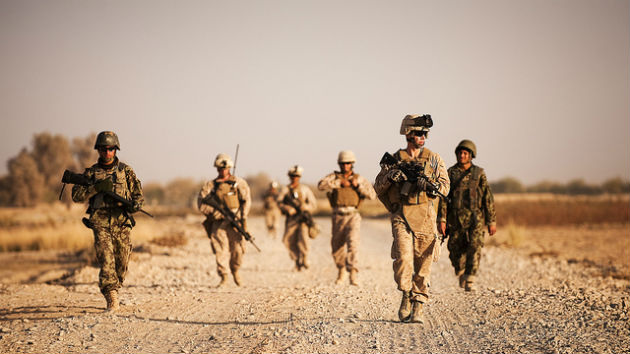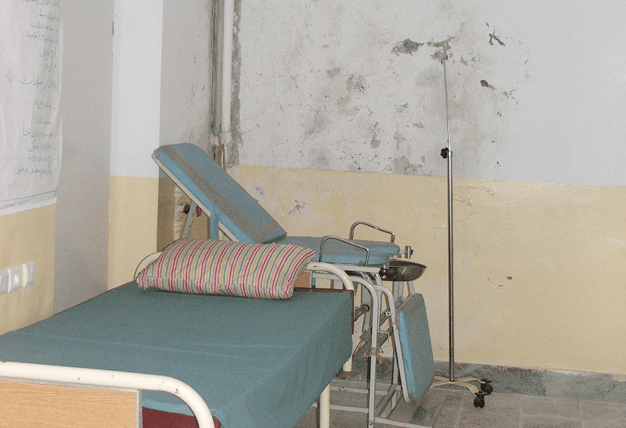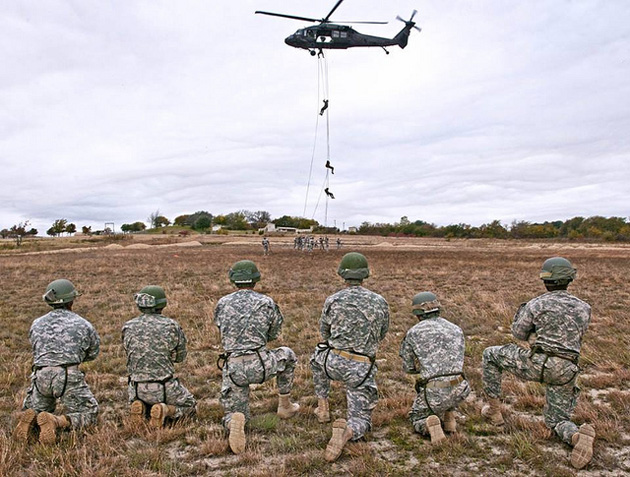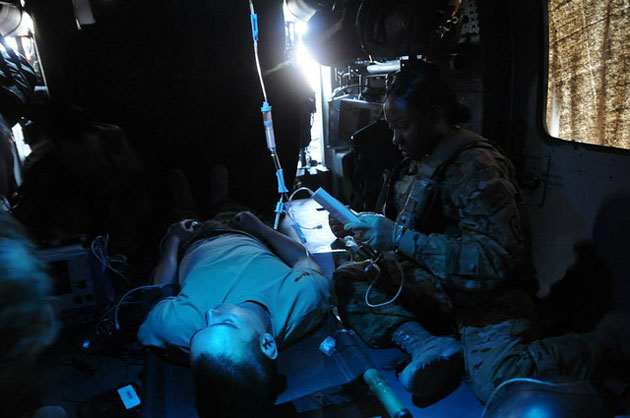
<a href="https://www.flickr.com/search/?l=deriv&q=afghan%20war%20army%20america">Marines</a>Flickr
This story first appeared on the TomDispatch website.
It was a typical Kabul morning. Malik Ashgar Square was already bumper-to-bumper with Corolla taxis, green police jeeps, honking minivans, and angry motorcyclists. There were boys selling phone cards and men waving wads of cash for exchange, all weaving their way around the vehicles amid exhaust fumes. At the gate of the Lycée Esteqial, one of the country’s most prestigious schools, students were kicking around a soccer ball. At the Ministry of Education, a weathered old Soviet-style building opposite the school, a line of employees spilled out onto the street. I was crossing the square, heading for the ministry, when I saw the suicide attacker.
He had Scandinavian features. Dressed in blue jeans and a white t-shirt, and carrying a large backpack, he began firing indiscriminately at the ministry. From my vantage point, about 50 meters away, I couldn’t quite see his expression, but he did not seem hurried or panicked. I took cover behind a parked taxi. It wasn’t long before the traffic police had fled and the square had emptied of vehicles.
![]() Twenty-eight people, mostly civilians, died in attacks at the Ministry of Education, the Ministry of Justice, and elsewhere across the city that day in 2009. Afterward, US authorities implicated the Haqqani Network, a shadowy outfit operating from Pakistan that had pioneered the use of multiple suicide bombers in headline-grabbing urban assaults. Unlike other Taliban groups, the Haqqanis’ approach to mayhem was worldly and sophisticated: they recruited Arabs, Pakistanis, even Europeans, and they were influenced by the latest in radical Islamist thought. Their leader, the septuagenarian warlord Jalaluddin Haqqani, was something like Osama bin Laden and Al Capone rolled into one, as fiercely ideological as he was ruthlessly pragmatic.
Twenty-eight people, mostly civilians, died in attacks at the Ministry of Education, the Ministry of Justice, and elsewhere across the city that day in 2009. Afterward, US authorities implicated the Haqqani Network, a shadowy outfit operating from Pakistan that had pioneered the use of multiple suicide bombers in headline-grabbing urban assaults. Unlike other Taliban groups, the Haqqanis’ approach to mayhem was worldly and sophisticated: they recruited Arabs, Pakistanis, even Europeans, and they were influenced by the latest in radical Islamist thought. Their leader, the septuagenarian warlord Jalaluddin Haqqani, was something like Osama bin Laden and Al Capone rolled into one, as fiercely ideological as he was ruthlessly pragmatic.
And so many years later, his followers are still fighting. Even with the US withdrawing the bulk of its troops this year, up to 10,000 Special Operations forces, CIA paramilitaries, and their proxies will likely stay behind to battle the Haqqanis, the Taliban, and similar outfits in a war that seemingly has no end. With such entrenched enemies, the conflict today has an air of inevitability—but it could all have gone so differently.
Though it’s now difficult to imagine, by mid-2002 there was no insurgency in Afghanistan: al-Qaeda had fled the country and the Taliban had ceased to exist as a military movement. Jalaluddin Haqqani and other top Taliban figures were reaching out to the other side in an attempt to cut a deal and lay down their arms. Tens of thousands of US forces, however, had arrived on Afghan soil, post-9/11, with one objective: to wage a war on terror.
As I report in my new book, No Good Men Among the Living: America, the Taliban, and the War Through Afghan Eyes, the US would prosecute that war even though there was no enemy to fight. To understand how America’s battle in Afghanistan went so wrong for so long, a (hidden) history lesson is in order. In those early years after 2001, driven by the idée fixe that the world was rigidly divided into terrorist and non-terrorist camps, Washington allied with Afghan warlords and strongmen. Their enemies became ours, and through faulty intelligence, their feuds became repackaged as “counterterrorism.” The story of Jalaluddin Haqqani, who turned from America’s potential ally into its greatest foe, is the paradigmatic case of how the war on terror created the very enemies it sought to eradicate.
The Campaign to Take Out Haqqani: 2001
Jalaluddin Haqqani stands at about average height, with bushy eyebrows, an aquiline nose, a wide smile, and an expansive beard, which in its full glory swallows half his face. In his native land, the three southeastern Afghan provinces known collectively as Loya Paktia, he is something of a war hero, an anti-Soviet mujahedeen of storied bravery and near mythical endurance. (Once, after being shot, he refused painkillers because he was fasting.) During the waning years of the Cold War, he was beloved by the Americans—Texas Congressman Charlie Wilson called him “goodness personified”—and by Osama bin Laden, too. In the 1980s, the US supplied him with funds and weapons in the battle against a Soviet-backed regime in Kabul and the Red Army, while radical Arab groups provided a steady stream of recruits to bolster his formidable Afghan force.
American officials had this history in mind when the second Afghan War began in October 2001. Hoping to convince Haqqani (who had backed the Taliban and al-Qaeda in the post-Soviet years) to defect, they spared his territory in Loya Paktia the intense bombing campaign that they had loosed on much of the rest of the country. The Taliban, for their part, placed him in charge of their entire military force, both sides sensing that his could be the swing vote in the war. Haqqani met with top Taliban figures and Osama bin Laden, only to decamp for Pakistan, where he took part in a flurry of meetings with Pakistanis and US-backed Afghans.
His representatives also began meeting American officials in Islamabad, the Pakistani capital, and the United Arab Emirates, and the Americans eventually offered him a deal: surrender to detention, cooperate with the new Afghan military authorities, and after a suitable period, he would be free to go. For Haqqani, one of Loya Paktia’s most respected and popular figures, the prospect of sitting behind bars was unfathomable. Arsala Rahmani, an associate of his, who would go on to serve as a senator in the Afghan government, told me, “He wanted to have an important position in Loya Paktia, but they offered to arrest him. He couldn’t believe it. Can you imagine such an insult?”
Haqqani declined the American offer, but left the door open to future talks. The prevailing ethos in the US, though, was that you were either with us or against us. “I personally always believed that Haqqani was someone we could have worked with,” a former US intelligence official told journalist Joby Warrick. “But at the time, no one was looking over the horizon, to where we might be in five years. For the policy folks, it was just ‘screw these little brown people.'”
In early November, the US began bombing Loya Paktia. Two nights later, warplanes attacked Haqqani’s home in the town of Gardez, near the Pakistani border. He was not present, but his brother-in-law and a family servant died in the blast. The next evening, US planes struck a religious school in the village of Mata China, one of many Haqqani had built in Afghanistan and Pakistan, which provided room, board, and education to poor children. Malem Jan, a Haqqani family friend, showed up the next morning. “I had never seen anything like it,” he said. “There were so many bodies. The roof was flattened to the ground. I saw one child who was alive under there, but no one could get him out in time.” Thirty-four people, almost all children, lost their lives.
Haqqani was in his primary residence in the nearby village of Zani Khel, a dusty cluster of mud houses that had once been an anti-Soviet stronghold. “We heard the blast, and then the sound of planes in the sky,” a cousin, who lived next door, told me. “We became very afraid.” Haqqani retreated to the house of Mawlawi Sirajuddin, a village chief. Not long after, the house shook violently from a direct airstrike. Haqqani was grievously wounded but managed to climb out of the rubble and escape. Sirajuddin, though, was not so lucky: his wife Fatima, three grandsons, six granddaughters, and 10 other relatives were killed.
The next morning, Haqqani sent word to his subordinates and former sub-commanders advising them to surrender. The Americans, however, had already found the local ally in Loya Paktia that they’d been looking for, a would-be warlord and supporter of the exiled Afghan king named Pacha Khan Zadran. With a thick uni-brow and handlebar mustache, PKZ (as he came to be known to the Americans) looked something like an Afghan Saddam Hussein. Flamboyant, illiterate, and quick-tempered, he was in many ways the opposite of Haqqani, under whom he had briefly fought during the anti-Soviet jihad. He had arrived in Loya Paktia shortly after the Taliban fled in mid-November and promptly declared himself governor of the three provinces. In no time, he had sealed his ties to the Americans by promising to deliver the man they now wanted most: Jalaluddin Haqqani.
“The last time I saw him,” Malem Jan said, “he was worried and upset. He told me to save myself and leave, because Pacha Khan would not allow us to live.” One early morning in late November, Haqqani slipped across the border into Pakistan. He would never be seen in public again.
An Attempt at Reconciliation Up in Flames: 2001
On December 20, 2001, the American-backed Hamid Karzai was preparing for his inauguration as interim president of Afghanistan. Nearly 100 of Loya Paktia’s leading tribal elders set out that afternoon in a convoy for Kabul to congratulate Karzai and declare their loyalty, a gesture that would go far in legitimizing his rule among the country’s border population. From Pakistan, Haqqani sent family members, close friends, and political allies to participate in the motorcade—an olive branch to the new government.
About 30 vehicles long, the convoy drove through the desert for hours. Near sunset, it reached a hilltop and was forced to stop: PKZ and hundreds of his armed men were blocking the road. Malek Sardar, an elder from Haqqani’s tribe, approached him. “He was demanding that the elders should accept him as leader of Loya Paktia,” Sardar told me. “He wanted our thumb prints and signatures right then and there.” Sardar promised to return after the inauguration to discuss the matter, but PKZ would not budge, so the convoy backed up and headed off to find a different route to Kabul.
On his satellite phone, Sardar called officials in the Afghan capital and at the US consulate in Peshawar, Pakistan, looking for help, but he was too late. PKZ, who had the ear of key American military figures, had informed them that a “Haqqani-al Qaeda” cavalcade was making its way toward Kabul. Shortly thereafter, amid deafening explosions, cars started bursting into flames. “We could see lights in the sky, fire everywhere. People were screaming and we ran,” Sardar said. The Americans were bombing the convoy. The attacks would continue for hours. As Sardar and others took cover in a pair of nearby villages, planes circled back and struck both locations, destroying nearly 20 homes and killing dozens of inhabitants. In all, 50 people, including many prominent tribal elders, died in the assault.
It was now late December, and in Qale Niazi, a village that had been a Haqqani stronghold in the 1980s, the bombing had frightened elders into taking control of a decades-old weapons dump. “We did not want Pacha Khan to take these weapons and use them,” said elder Fazel Muhammad. “They should belong to the government of Karzai, so we guarded it until they came.”
He was on his way to the village one night for a wedding party when he heard the American planes. A moment later, mud houses ahead of him exploded in a direct hit. A second bomb struck the weapons depot, setting off a series of eruptions. The night sky lit up, illuminating fleeing women and children. “Some helicopters came,” Muhammad said, “and then these people were no more.”
In the morning, Fazel Muhammad went looking for the house of his relatives, where the wedding party had been, but all he found there were pulverized mud bricks, twisted picture frames, deformed pots, a child’s shoe, a scalp with braided hair, and severed human fingers. Later, a tribal commission set up to investigate the massacre determined that PKZ had fed the Americans “intelligence” that Qale Niazi was a Haqqani stronghold. According to a United Nations investigation, 52 people had died: 17 men, 10 women, and 25 children.
Reconciliation and Flames: 2002
In six weeks, America’s campaign to kill Jalaluddin Haqqani had resulted in 159 dead civilians, a flattened village, 37 destroyed homes, a fractured tribal leadership, and the ascendancy of one man, Pacha Khan Zadran, as the most important player in Loya Paktia. Meanwhile, Haqqani and his followers were in hiding in Pakistan, watching the three provinces in which they had enjoyed prestige and riches slip out of their grasp. Life inside Pakistan proved little better. While Haqqani hid in Peshawar, his family had retreated to a suburb of Miram Shah, the capital of the tribal agency of North Waziristan. The Pakistani military was, at that point, working closely with Washington to round up al-Qaeda and Taliban suspects. In December, its troops raided the Miram Shah home, arresting his son Sirajuddin. Weeks later, they stormed the Peshawar hideout, with Haqqani barely escaping.
 In the following months, US Special Forces teams staged secret incursions into Pakistan to raid Haqqani homes and seminaries, inciting anger in the local community. “We will never allow anybody to destroy our religious institutions,” said Hajji Salam Wazir, a tribal elder. “I am surprised how the Americans use the Muslims,” he added. “Until yesterday, Haqqani was a hero and freedom fighter for the US, and they sent their own military experts to train him. Now he is a terrorist.”
In the following months, US Special Forces teams staged secret incursions into Pakistan to raid Haqqani homes and seminaries, inciting anger in the local community. “We will never allow anybody to destroy our religious institutions,” said Hajji Salam Wazir, a tribal elder. “I am surprised how the Americans use the Muslims,” he added. “Until yesterday, Haqqani was a hero and freedom fighter for the US, and they sent their own military experts to train him. Now he is a terrorist.”
Caught between the threat of Pakistani arrest and American assassination, Haqqani decided to reach out again to the new Afghan government. In March 2002, he dispatched his brother Ibrahim Omari to Afghanistan in a bid to reconcile with Karzai. In a public ceremony attended by hundreds of tribal elders and local dignitaries, Omari pledged allegiance to the new government and issued a call for Haqqani followers to return from Pakistan and work with the authorities. He was then appointed head of Paktia province’s tribal council, an institution meant to link village elders with the Kabul government. Soon, hundreds of Haqqani’s old sub-commanders, who had been hiding in fear of PKZ, came in from the cold.
Malem Jan was one of them. With long, curling eyelashes, daubs of kohl under his eyes, and polished fingernails, he had a taste for dancing, which he often performed solo to the delight of his comrades. He was also an accomplished commander, having fought under Haqqani during the early 1990s against the Communist government. In the spring of 2002, he rounded up his old fighters and soon they were working for the CIA as a paramilitary unit, providing security for American missions in search of al-Qaeda.
“It was a good time,” Malem Jan recalled. “We were working closely together, sharing meals, sharing gossip.” The CIA militias, of which there were a half-dozen in Loya Paktia, would soon enough grow into a 3,000-man shadow army, collectively called Counterterrorism Pursuit Teams, which operates to this day outside of the Afghan government’s jurisdiction and answers only to US forces.
Contacts between Haqqani and the CIA were rekindled, with his brother Omari acting as the intermediary. Plans were made for a meeting between Haqqani himself and Agency representatives. Key to a deal was the assurance that he would be allowed to return to Afghanistan and take part in Loya Paktia politics. The trouble was PKZ, who viewed such maneuverings with jealousy and was still angling to control the three provinces outright. “I must be allowed to take over as governor,” he declared to the Austin American-Statesman. “If it’s not me, it will be someone from al-Qaeda.”
When Karzai appointed a new man to head Paktia province, PKZ made his move, laying siege to the governor’s mansion and killing 25 people. At the same time, he convinced American military officers to clamp down on the Haqqanis. One evening, as Omari was visiting the house of a government official near Kabul, US Special Operations forces showed up—without the CIA’s knowledge—and arrested him. That week, similar arrests of Haqqani followers took place across Loya Paktia.
As soon as Malem Jan realized what was happening, he fled to Pakistan, but a number of his subordinates were rounded up and dispatched to the new American prison at Bagram Air Base, a quickly expanding military command center. Swat Khan, his deputy, said that in his initial questioning he was hung by his wrists from the ceiling. Later, he was beaten. Finally, he was shipped to Guantanamo, where, a few years later, he attempted suicide. “It’s all there when I close my eyes,” he told me after his release. “The nightmare never leaves me.”
It took the CIA months to realize that Omari was in an American lockup. When he was finally released, he looked like a different man. It was a cold autumn day, on a hilltop near the town of Khost, when hundreds of tribal elders and government officials came to receive him. There were dignitaries from villages that had been bombed and attacked by American planes and PKZ’s forces, elders who had survived the disastrous convoy, farmers whose sons had been sent to Guantanamo.
“At first I couldn’t even recognize him,” said tribal elder Malek Sardar. “He wouldn’t talk about what they had done to him. It seemed too painful to ask.” Slowly, his voice quivering, Omari addressed the crowd. There was no hope in this government or the Americans, he told them. Some elders shouted insults at Karzai. Others said the Americans were no different from the Russians. Omari swore he would never set foot on Afghan soil again until it was free of “the infidels.” Not long after, he left for Pakistan.
The Haqqani Network: 2004-2014
In the summer of 2004, Malem Jan was sitting with Sirajuddin Haqqani, the second son of Jalaluddin, in their Pakistani base in the North Waziristan town of Miram Shah when they heard their names on the BBC. The Americans were offering $250,000 and $200,000, respectively, as rewards for information leading to their capture. Introverted, religious, and fiercely intelligent, the younger Haqqani was rapidly taking over the reins of his ailing father’s network, and he smiled at the thought of his deputy, Malem Jan, fetching a larger reward than him. “They say he who has the highest bounty on his head is the closest to God,” he joked.
The Haqqanis were now in open war against the Americans. Whereas his father had presided over Loya Paktia with popular support, Sirajuddin ruled from the shadows through fear—assassinations, kidnappings, extortion, and roadside bombings. Miram Shah had become the world capital of radical jihad, home to al-Qaeda and an assortment of Chechens, Uzbeks, and Europeans fighting under Haqqani’s banner. The ISI, Pakistan’s intelligence service, was now supporting the Haqqanis as way of influencing events inside Afghanistan, even as Islamabad publicly allied with Washington.
By classifying certain groups as terrorists, and then acting upon those classifications, the US had inadvertently brought about the very conditions it had set out to fight. By 2010, the Haqqani network was the deadliest wing of an increasingly violent insurgency that was claiming the lives of countless civilians, as well as American soldiers. It was hard, by then, even to recall that, back in mid-2002, US forces had been without an enemy: the remnants of al-Qaeda had fled to Pakistan, the Taliban had collapsed, and the Haqqanis were attempting to reconcile.
If Pacha Khan Zadran was able to convince his American allies otherwise, it was because of the logic of the war on terror. “Terrorism” was understood not as a set of tactics (hostage taking, assassinations, car bombings), but as something rooted in the identity of its perpetrators, like height or temperament. This meant that, once designated a “terrorist,” Jalaluddin Haqqani could never shake the label, even when he attempted to reconcile. On the other hand, when PKZ eventually broke with the Karzai government and turned his guns on the Americans, he was labeled not a terrorist but a “renegade.” (He eventually fled to Pakistan, was arrested, turned over to the Afghan government, and later was elected to parliament.)
In recent years, the US has waged an intense drone campaign against the Haqqanis in their North Waziristan stronghold. Dozens of their commanders have been killed, including their top military chief, Badruddin Haqqani. Many others have been arrested. Today, the Haqqani network is a shadow of its former self.
The group’s influence, however, lives on. In 2012, I received a phone call from the family of Arsala Rahmani, the Afghan senator with whom I’d become friendly. That morning, a gunman had pulled up alongside Rahmani’s vehicle, idling in a crowded intersection, and shot him point blank. Later, I learned that a former Haqqani-aligned commander named Najibullah was the culprit; he had launched his own faction, Mahaz-e-Fedayeen, whose ruthlessness made the Haqqanis look like amateurs. Now in the crosshairs of US counterterrorism forces, his group is but the latest enemy in a war that never seems to end.
Anand Gopal, a TomDispatch regular, is the author of the just-published No Good Men Among the Living: America, the Taliban, and the War Through Afghan Eyes (Metropolitan Books). He reported on the Afghan War for the Wall Street Journal and the Christian Science Monitor and is now a fellow of the New America Foundation. You can follow him on twitter @Anand_Gopal_.
Follow TomDispatch on Twitter and join us on Facebook and Tumblr. Check out the newest Dispatch Book, Ann Jones’s They Were Soldiers: How the Wounded Return From America’s Wars—The Untold Story. To stay on top of important articles like these, sign up to receive the latest updates from TomDispatch.com here.















